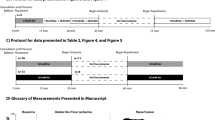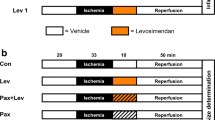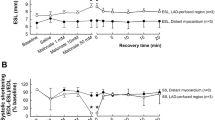Abstract
Inhibition of Na+/H+ exchange with amiloride analogues has been shown to offer functional protection during ischemia and reperfusion and reduce infarct size in isolated rat hearts and intact pigs. The aim of the present study was to examine if pre- or postischemic treatment with ethylisopropylamiloride (EIPA), a selective Na+/H+ exchange inhibitor, could reduce infarct size in anin situ rabbit model of regional ischemia and reperfusion. Anesthetized, open-chest rabbits were subjected to 30 min of regional ischemia and 180 min of reperfusion. The risk zone was determined by fluorescent particles, and infarct size was determined by TTC staining. Preischemic treatment with EIPA (0.65 mg/kg) significantly reduced infarct size from 45.8±3.5% of the risk zone in the control group to 10.6±3.1% (p<0.01). EIPA-treatment during the first part of the reperfusion period did not reduced infarct size compared to controls (41.9±3.5%). We conclude that EIPA, when administered prior to ischemia, reduces infarct size in the rabbit heartin situ, a protection most likely due to inhibition of Na+/H+ exchange.
Similar content being viewed by others
References
Anderson SE, Murphy E, Steenbergen C, London RE, Cala PM (1990) Na/H exchange in myocardium: Effects of hypoxia and acidification on Na and Ca. Am J Physiol 259: C940-C948
Gugge E, Ytrehus K (1995) Inhibition of sodium-hydrogen exchange reduces infarct size in the isolated rat heart—a protective additive to ischaemic preconditioning. Cardiovasc Res 29: 269–274
Burmeister WE, Reynolds RD, Lee RJ (1981) Limitation of myocardial infarct size by atenolol, nadolol and propranolol in dogs. Eur J Pharmacol 75: 7–10
Dennis SC, Coetzee WA, Cragoe EJ, Oipie LH (1990) Effects of proton buffering and of amiloride derivatives on reperfusion arrhythmias in isolated rat hearts. Possible evidence for an arrhythmogenic role of Na+/H+ exchange. Circ Res 66: 1156–1159
Duan J, Karmazyn M (1992) Protective effects of amiloride on the ischemic reperfused rat heart. Relation to mitochondrial function. Eur J Pharmacol 210: 149–157
Duff HJ, Brown E, Cragoe EJ, Rahmberg M (1991) Antiarrhythmic activity of amiloride: Mechanisms. J Cardiovasc Pharmacol 17: 879–888
Frelin C, Vigne P, Lazdunski M (1984) The role of the Na+/H+-exchange system in cardiac cells in relation to the control of the internal Na+ concentration. J Biol Chem 259: 8880–8885
Gold MR, Stricharz GR (1991) Use-dependent block of atrial sodium current by ethylisopropylamiloride. J Cardiovasc Pharmacol 17: 792–799
Gross RW (1992) Myocardial phospholipases A2 and their membrane substrates. Trends Cardiovasc Med 2: 115–121
Harrison DC, Lemasters JJ, Herman B (1991) A ph-dependent phospholipase A2 contributes to loss of plasma membrane integrity during chemical hypoxia in rat hepatocytes. Biochem Biophys Res Com 174: 654–659
Hendrikx M, Mubagwa K, Verdonck F, Overloop K, Van Hecke P, Vanstapel F, Van Lommel A, Verbeken E, Lauweryns J, Flameng W (1994) New Na+/H+ exchange inhibitor HOE 694 improves postischemic function and high-Energy phosphate resynthesis and reduces Ca2+ overload in isolated perfused rabbit heart. Circulation 89: 2787–2798
Jennings RB, Reimer KA, Steenbergen C (1986) Myocardial ischemia revisited: The osmolar load, membrane damage, and reperfusion. J Mol Cell Cardiol 18: 769–780
Karmazyn M (1988) Amiloride enhances postischemic ventricular recovery: Possible role of Na+/H+ exchange. Am J Physiol 255: H608-H615
Karmazyn M (1991) The 1990 Merck Frosst Award. Ischemic and reperfusion injury in the heart. Cellular mechanisms and pharmacological interventions. Can J Physiol Pharmacol 69: 719–730
Karmazyn M, Moffat MP (1993) Role of Na+/H+ exchange in cardiac physiology and pathophysiology: mediation of myocardial reperfusion injury by the pH paradox. Cardiovasc Res 27: 915–924
Karmazyn M, Ray M, Haist JV (1993) Comparative effects of Na+/H+ exchange inhibitors against cardiac injury produced by ischemia/reperfusion, hypoxia/reoxygenation, and the calcium paradox. J Cardiovasc Pharmacol 21: 172–178
Klein HH, Pich S, Bohle RM, Wollenweber J, Nebendahl K (1995) Myocardial protection by Na+/H+ exchange inhibition in ischemic, reperfused porcine hearts. Circulation 92: 912–917
Kleyman TR, Cragoe EJ (1988) Amiloride and its analogs as tools in the study of ion transport. J Membrane Biol 105: 1–21
Kloner RA, Braunwald E (1987) Effects of calcium antagonists on infarcting myocardium. Am J Cardiol 59: 84B-94B
Lazdunski M, Frelin C, Vigne P (1985) The sodium/hydrogen exchange system in cardiac cells: Its biochemical and pharmacological properties and its role in regulating internal concentrations of sodium and internal pH. J Mol Cell Cardiol 17: 1029–1042
Liu GS, Thornton J, Van Winckle DM, Stanley AWH, Olsson RA, Downey JM (1991) Protection against infarction afforded by preconditioning is mediated by A1 Adenosine receptors in rabbit heart. Circulation 84: 350–356
Meng H-P, Lonsberry BB, Pierce GN (1991) Influence of perfusate pH on the postischemic recovery of cardiac contractile function: Involvement of sodium-hydrogen exchange. J Pharmacol Exp Ther 258: 772–777
Meng H-P, Pierce GN (1990) Protective effects of 5′-(N,N-dimethyl)amiloride on ischemia-reperfusion injury in hearts. Am J Physiol 258: H1615-H1619
Moffat MP, Karmazyn M (1993) Protective effect of the potent Na/H exchange inhibitor methylisobutyl amiloride against postischemic contractile dysfunction in rat and guinea-pig hearts. J Mol Cell Cardiol 25: 959–971
Otani H, Engelman RM, Rousou JA, Breyer RH, Das DK (1986) Enhanced prostaglandin synthesis due to phospholipid breakdown in ischemic-reperfused myocardium. J Mol Cell Cardiol 18: 953–961
Pierce GN, Cole WC, Liu K, Massaeli H, Maddaford TG, Chen YJ, McPherson CD, Jain S, Sontag D (1993) Modulation of cardiac performance by amiloride and several selected derivatives of amiloride. J Pharmacol Exp Ther 265: 1280–1291
Piwnica-Worms D, Jacob R, Horres R, Lieberman M (1985) Na/H exchange in cultured chick heart cells. pHi regulation. J Gen Physiol 85: 43–64
Piwnica-Worms D, Jacob R, Shigeto N, Horres R, Lieberman M (1986) Na/H exchange in cultured chick heart cells: Secondary stimulation of electrogenic transport during recovery from intracellular acidosis. J Mol Cell Cardiol 18: 1109–1116
Regan TJ, Broisman L, Haider B, Eaddy C, Oldewurtel HA (1980) Dissociation of myocardial sodium and potassium alterations in mild versus severe ischemia. Am J Physiol 238: H575-H580
Sack S, Mohri M, Schwarz ER, Arras M, Schaper J, Ballagi Pordany G, Scholz W, Lang HJ, Scholkens BA, Schaper W (1994) Effects of a new Na+/H+ antiporter inhibitor on postischemic reperfusion in pig heart. J Cardiovasc Pharmacol 23: 72–78
Scholz W, Albus U, Linz W, Martorana P, Lang HJ, Schölkens BA (1992) Effects of Na+/H+ exchange inhibitors in cardiac ischemia. J Mol Cell Cardiol 24: 731–740
Siffert W (1995) Regulation of platelet function by sodium-hydrogen exchange. Cardiovasc Res 29: 160–166
Tani M, Neely JR (1989) Role of intracellular Na+ in Ca2+ overload and depressed recovery of ventricular function of reperfused ischemic rat hearts. Possible involvement of Na+−H+ and Na+−Ca2+ exchange. Circ Res 65: 1045–1056
van den Bosch H (1980) Intracellular phospholipases A. Biochimica et Biophysica Acta 604: 191–246
Vigne P, Frelin C, Cragoe EJ, Lazdunski M (1983) Ethylisopropyl-amiloride: A new and highly potent derivative of amiloride for the inhibition of the Na+/H+ exchange system in various cell types. Biochem Biophys Res Com 116: 86–90
Vigne P, Frelin C, Cragoe EJ, Lazdunski M (1984) Structure-activity relationships of amiloride and certain of its analogues in relation to the blockade of the Na+/H+-exchange system. Mol Pharm 25: 131–136
Yan G-X, Kléber AG (1992) Changes in extracellular and intracellular pH in ischemic rabbit papillary muscle. Circ Res 71: 460–470
Yasutake M, Ibuki C, Hearse DJ, Avkiran M (1994) Na+/H+ exchange and reperfusion arrhythmias: protection by intracoronary infusion of a novel inhibitor. Am J Physiol 267: H2430-H2440
Ytrehus K, Downey JM (1993) Experimental models assessing the physiology of myocardial ischemia. Curr Opin Cardiol 8: 581–588
Author information
Authors and Affiliations
Rights and permissions
About this article
Cite this article
Bugge, E., Munch-Ellingsen, J. & Ytrehus, K. Reduced infarct size in the rabbit heartin vivo by ethylisopropyl-amiloride. A role for Na+/H+ exchange. Basic Res Cardiol 91, 203–209 (1996). https://doi.org/10.1007/BF00788906
Received:
Revised:
Accepted:
Issue Date:
DOI: https://doi.org/10.1007/BF00788906




